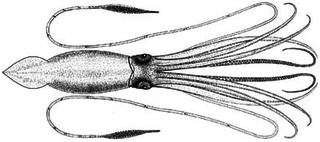
The giant squid is a species of deep-ocean dwelling squid in the family Architeuthidae. It can grow to a tremendous size, offering an example of abyssal gigantism: recent estimates put the maximum size at around 12–13 m (39–43 ft) for females and 10 m (33 ft) for males, from the posterior fins to the tip of the two long tentacles. The mantle of the giant squid is about 2 m long, and the length of the squid excluding its tentacles rarely exceeds 5 m (16 ft). Claims of specimens measuring 20 m (66 ft) or more have not been scientifically documented.

Joubiniteuthis portieri, also known as Joubin's squid from the monotypic family Joubiniteuthidae and genus Joubiniteuthis. It is a rare, small squid which occurs in the mesopelagic to bathypelagic zones and which has a worldwide distribution in tropical and subtropical regions. It is a distinctive squid having long arms I-III which have numerous small suckers in six rows. Its biology is little known and it is thought that it stays in the depths of the ocean with its arms outstretched waiting for small animals to ensnare after they have accidentally swum into the arms. This species is named after Louis Joubin, a French zoologist. It is known to reach a mantle length of 9 cm.

Lepidoteuthis grimaldii, also known as the Grimaldi scaled squid, is a large squid growing to 1 m in mantle length. It is named after the Grimaldi family, reigning house of Monaco. Prince Albert I of Monaco was an amateur teuthologist who pioneered the study of deep sea squids by collecting the 'precious regurgitations' of sperm whales. The Grimaldi scaled squid was first collected from the stomach contents of a sperm whale. It is a widely distributed species in tropical and subtropical areas of the North and South Atlantic, the southern Indian Ocean and the Pacific Ocean, where it has been recorded off Japan and in the west Pacific.

Bigfin squids are a group of rarely seen cephalopods with a distinctive morphology. They are placed in the genus Magnapinna and family Magnapinnidae. Although the family was described only from larval, paralarval, and juvenile specimens, numerous video observations of much larger squid with similar morphology are assumed to be adult specimens of the same family.

Grimpoteuthis is a genus of pelagic cirrate (finned) octopods known as the dumbo octopuses. The name "dumbo" originates from their resemblance to the title character of Disney's 1941 film Dumbo, having a prominent ear-like fin which extends from the mantle above each eye. There are 17 species recognized in the genus. Prey include crustaceans, bivalves, worms and copepods. The average life span of various Grimpoteuthis species is 3 to 5 years.

Taningia danae, the Dana octopus squid, is a species of squid in the family Octopoteuthidae. It is one of the largest known squid species, reaching a mantle length of 1.7 m (5.6 ft) and total length of 2.3 m (7.5 ft). The largest known specimen, a mature female, weighed 161.4 kg (356 lb).
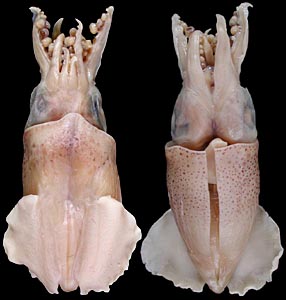
A. aldrichi is a small species of squid found in northern Australian waters. The species was described by Chung Cheng Lu in 2005 based on specimens collected in the inshore waters of Northern Australia. The largest known individual of this species is a mature female measuring 27.6 mm (1.09 in) in mantle length (ML). The holotype is a mature male of 21.3 mm (0.84 in) ML. A live specimen of A. aldrichi has yet to be recorded. A. aldrichi is a member of the class Cephalopoda and part of the subclass Coleodia. Within this class there are two orders, the Myopsida and Oegopsida, which both fall under the superorder Decapodiformes. A. aldrichi falls under the order of Myospida, and is the only member of its genus, Australiteuthis, and family, Australiteuthidae.

Magnapinna atlantica, previously known as "Magnapinna sp. A", is a species of bigfin squid known from only two specimens collected in the northern Atlantic Ocean. It is characterised by several unique morphological features: the tentacle bases are narrower than adjacent arm bases, the proximal tentacle lacks suckers but possesses glandular structures, and the animal's pigment is contained mostly in functional chromatophores.
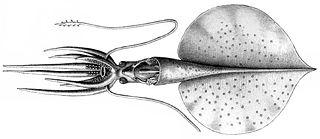
Magnapinna talismani is a species of bigfin squid known only from a single damaged specimen. It is characterised by small white nodules present on the ventral surface of its fins.
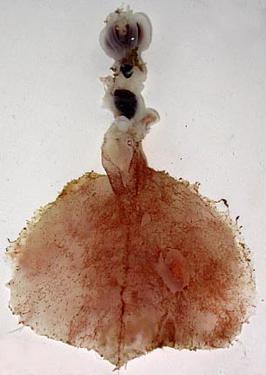
Magnapinna sp. B is an undescribed species of bigfin squid known only from a single immature specimen collected in the northern Atlantic Ocean.

Magnapinna sp. C is an undescribed species of bigfin squid known only from a single specimen of 79-millimetre (3.1 in) mantle length (ML) collected in the southern Atlantic Ocean and held in the Natural History Museum.

The thorny whiplash squid,known as Asperoteuthis acanthoderma is a large species of squid belonging to the family Chiroteuthidae. It is characterised by the tiny, pointed tubercules present on its skin and a Y-shaped groove in the funnel locking apparatus.
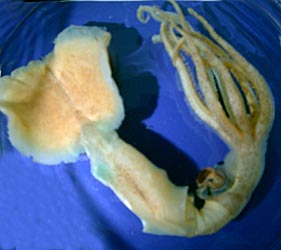
Asperoteuthis mangoldae, previously known as Asperoteuthis sp. A, is a chiroteuthid squid known only from the waters off the Hawaiian Islands. It differs from the closely related Asperoteuthis acanthoderma in lacking integumental tubercles and elongate fins. This species also possesses a characteristic curved groove in its funnel locking apparatus.

Histioteuthis bonnellii, the umbrella squid, is a species of cock-eyed squid belonging to the family Histioteuthidae.
Stigmatoteuthis arcturi, commonly known as the jewelled squid, is a species of cock-eyed squid from the family Histioteuthidae. It occurs throughout the subtropical and tropical Atlantic Ocean in the mesopelagic zone.

The colossal squid is part of the family Cranchiidae. It is sometimes called the Antarctic squid or giant cranch squid and is believed to be the largest squid species in terms of mass. It is the only recognized member of the genus Mesonychoteuthis and is known from only a small number of specimens. The species is confirmed to reach a mass of at least 495 kilograms (1,091 lb), though the largest specimens—known only from beaks found in sperm whale stomachs—may perhaps weigh as much as 600–700 kilograms (1,300–1,500 lb), making it the largest known invertebrate. Maximum total length has been estimated at 9–10 metres (30–33 ft). The colossal squid has the largest eyes of any known creature ever to exist, with an estimated diameter of 27 cm (11 in).

Illex coindetii, commonly known as the southern shortfin squid or broadtail shortfin squid, is a species of neritic squids in the family Ommastrephidae. They are found in the Mediterranean Sea and on both sides of the north Atlantic Ocean.

Cephalopods exhibit various dermal structures on their mantles and other parts. These may take the form of conspicuous warts, cushions, papillae or scales, though in many species they are microscopic tubercles. The most elaborate forms are found among the oceanic squid of the order Teuthida.

Taonius belone is a glass squid belonging to the genus Taonius from the family Cranchiidae. It occurs in the northern subtropical and in the tropical or equatorial waters of the Pacific and Indian Oceans.
Richard E. Young is a teuthologist. He is an Emeritus Professor of Oceanography at the University of Hawaii's School of Ocean and Earth Science and Technology.



















